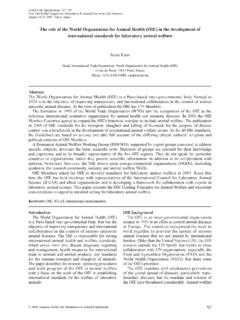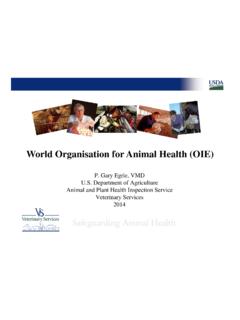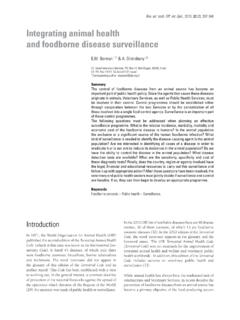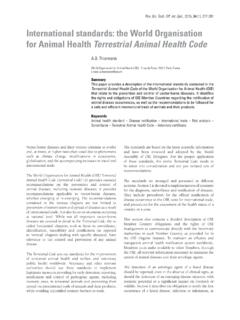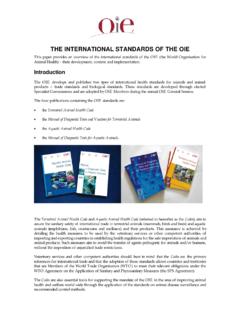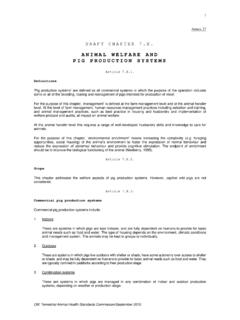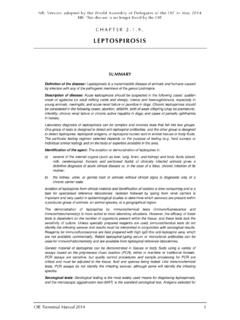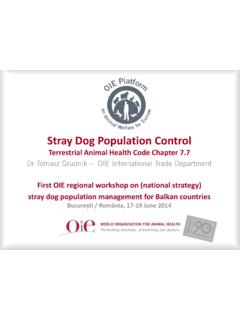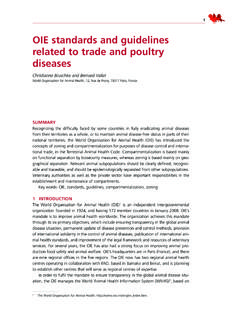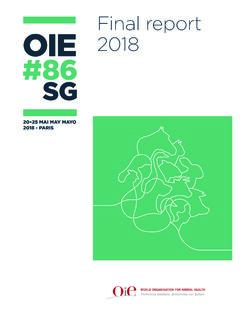Transcription of TERRESTRIAL ANIMAL HEALTH CODE
1 WORLD ORGANISATION FOR ANIMAL HEALTHO rganisation Mondiale de la Sant Animale World Organisation for ANIMAL HEALTH Organizaci n Mundial de Sanidad AnimalTERRESTRIALANIMAL HEALTHCODEVOLUME IGeneral provisionsTwentieth edition, 2011 First edition, 1968 Second edition, 1971 Third edition, 1976 Fourth edition, 1982 Fifth edition, 1986 Sixth edition, 1992 Seventh edition, 1998 Eighth edition, 1999 Ninth edition, 2000 Tenth edition, 2001 Eleventh edition, 2002 Twelfth edition, 2003 Thirteenth edition, 2004 Fourteenth edition, 2005 Fifteenth edition, 2006 Sixteenth edition, 2007 Seventeenth edition, 2008 Eighteenth edition, 2009 Nineteenth edition, 2010 OIE - TERRESTRIAL ANIMAL HEALTH Code Twentieth edition, 2011 ISBN 978-92-9044-825-9 World Organisation for ANIMAL HEALTH (OIE) 2011 12, rue de Prony, 75017 Paris, France Telephone: 33-(0)1 44 15 18 88 Fax: 33-(0)1 42 67 09 87 E-mail: All World Organisation for ANIMAL HEALTH (OIE) publications are protected by international copyright law.
2 Extracts may be copied, reproduced, translated, adapted or published in journals, documents, books, electronic media and any other medium destined for the public, for information, educational or commercial purposes, provided prior written permission has been granted by the OIE. The designations and denominations employed and the presentation of the material in this publication do not imply the expression of any opinion whatsoever on the part of the OIE concerning the legal status of any country, territory, city or area or of its authorities, or concerning the delimitation of its frontiers and boundaries. Copyright for the photos Zebra/rabbit/lambs/duck/bee/hairy pigs: ( ) Transport of cows: Mr G. Marot Carcasses: OIE 2007 Photo of the virus: Kindly provided by Dr Michael Baron (Institute for ANIMAL HEALTH , Pirbright Laboratory, United Kingdom).
3 Syncitium formed from cells infected with recombinant rinderpest virus expressing GFP (green fluorescent protein). Photo taken by Dr Ashley Banyard & Dr Paul Monaghan. Citation: Banyard , Simpson J., Monaghan P. & Barrett T. (2010). Rinderpest virus expressing enhanced green fluorescent protein as a separate transcription unit retains pathogenicity for cattle. J. Gen. Virol., 91 (Pt 12), 2918 2927. CONTENTSVOLUMEIG eneral 's guideGlossaryANIMAL DISEASE DIAGNOSIS,SURVEILLANCE AND NOTIFICATIONN otification of diseases and epidemiological informationCriteria for listing diseasesPrescribed and alternative diagnostic tests for OIE listed diseasesAnimal HEALTH surveillanceSurveillance for arthropod vectors of ANIMAL diseasesProcedures for self declaration and for official recognition by theOIERISK ANALYSISI mport risk analysisQUALITY OF VETERINARY SERVICESV eterinary ServicesEvaluation of Veterinary ServicesCommunicationGENERAL RECOMMENDATIONS.
4 DISEASE PREVENTION AND CONTROLG eneral principles on identification and traceability of live animalsDesign and implementation of identification systems to achieveanimal traceabilityZoning and compartmentalisationApplication of compartmentalisationGeneral hygiene in semen collection and processing centresCollection and processing of bovine, small ruminant and porcinesemenCollection and processing ofin vivoderived embryos fromlivestock and horsesCollection and processing ofin vitroproduced embryos/oocytesfrom livestock and horsesCollection and processing of micromanipulated embryos/oocytesfrom livestock and horsesCollection and processing of laboratory rodent and rabbitembryos/ovaSomatic cell nuclear transfer in production livestock and horsesDisposal of dead animalsGeneral recommendations on disinfection and disinsectisationHygiene and disease security procedures in apiariesHygiene precautions, identification, blood sampling andvaccinationTRADE MEASURES.
5 IMPORT/EXPORT PROCEDURES AND VETERINARY CERTIFICATIONG eneral obligations related to certificationCertification proceduresvviiix149142529677377969910110 8112117120128136141144150158165168171173 1762011 OIE - TERRESTRIAL ANIMAL HEALTH CodeiiiChapter procedures relevant to the Agreement on the Application ofSanitary and Phytosanitary Measures of the World TradeOrganizationAnimal HEALTH measures applicable before and at departureAnimal HEALTH measures applicable during transit from the place ofdeparture in the exporting country to the place of arrival in theimporting countryBorder posts and quarantine stations in the importing countryAnimal HEALTH measures applicable on arrivalInternational transfer and laboratory containment of animalpathogensQuarantine measures applicable to non-human primatesModel veterinary certificates for international trade in live animals,hatching eggs and products of ANIMAL originModel international veterinary certificate for dogs and catsoriginating from rabies infected countriesModel passport for international movement of competition horsesVETERINARY PUBLIC HEALTHThe role of the Veterinary Services in food safetyControl of biological hazards of ANIMAL HEALTH and public healthimportance through ante- and post-mortem meat inspectionThe control of hazards of ANIMAL HEALTH and public healthimportance in ANIMAL feedBiosecurity procedures in poultry productionPrevention.
6 Detection and control ofSalmonellain poultryIntroduction to the recommendations for controlling antimicrobialresistanceHarmonisation of national antimicrobial resistance surveillance andmonitoring programmesMonitoring of the quantities of antimicrobials used in animalhusbandryResponsible and prudent use of antimicrobial agents in veterinarymedicineRisk assessment for antimicrobial resistance arising from the use ofantimicrobials in animalsZoonoses transmissible from non-human primatesANIMAL WELFAREI ntroduction to the recommendations for ANIMAL welfareTransport of animals by seaTransport of animals by landTransport of animals by airSlaughter of animalsKilling of animals for disease control purposesStray dog population controlUse of animals in research and education1781851871901921961982022132182 3323824124525125725826526827728328929130 6323332356382397 Contentsiv2011 OIE - TERRESTRIAL ANIMAL HEALTH CodeFOREWORDThe OIET errestrial ANIMAL HEALTH Code( TERRESTRIAL Code) sets out standards for the improvement of terrestrialanimal HEALTH and welfare and veterinary public HEALTH worldwide, including through standards for safe internationaltrade in TERRESTRIAL animals (mammals, birds and bees) and their products.
7 The HEALTH measures in theTerrestrialCodeshould be used by the veterinary authorities of importing and exporting countries to provide for early detection,reporting and control agents pathogenic to TERRESTRIAL animals and, in the case of zoonoses, for humans, and to preventtheir transfer via international trade in TERRESTRIAL animals and TERRESTRIAL ANIMAL products, while avoiding unjustifiedsanitary barriers to HEALTH measures in theTerrestrial Codehave been formally adopted by the World Assembly of OIE Delegates,which constitutes the organisation's highest decision-making body. The 20th edition incorporates modifications to theTerrestrial Codeagreed at the 79th OIE General Session in May 2011. The 2011 edition includes revisedinformation on the following subjects: glossary; notification of diseases and epidemiological information; procedures forself declaration and for official recognition by the OIE; Veterinary Services; evaluation of Veterinary Services; designand implementation of identification systems to achieve ANIMAL traceability; zoning and compartmentalisation;application of compartmentalisation; general hygiene in semen collection and processing centres; collection and processingof bovine, small ruminant and porcine semen; collection and processing ofin vivoderived embryos from livestock andhorses; general recommendations on disinfection and disinsectisation; certification procedures; OIE procedures relevantto the Agreement on the Application of Sanitary and Phytosanitary Measures of the World Trade Organization.
8 Quarantine measures applicable to non-human primates; model veterinary certificates for international trade in liveanimals, hatching eggs and products of ANIMAL origin; control of hazards of ANIMAL HEALTH and public HEALTH importancein ANIMAL feed; biosecurity procedures in poultry production; prevention, detection and control ofSalmonellain poultry;transport of animals by land; transport of animals by air; slaughter of animals; killing of animals for disease controlpurposes; control of stray dog populations and use of animals in research and education; anthrax; Aujeszky's disease;bluetongue; foot and mouth disease; vesicular stomatitis; avian influenza; Newcastle disease; contagious bovinepleuropneumonia; lumpy skin disease; equine influenza; equine viral arteritis;Chlamydophila abortusinfection chapters on avian tuberculosis, duck virus enteritis, fowl cholera, Marek's disease and teschovirus encephalomyelitiswere deleted from this new chapter on communication has been incorporated into this development of these standards and recommendations is the result of the ongoing work by the OIE TerrestrialAnimal HEALTH Standards Commission (the Code Commission).
9 This Commission, which comprises six electedmembers, meets twice yearly to address its work programme. The Commission draws upon the expertise ofinternationally renowned scientific experts to prepare draft texts for new texts in theTerrestrial Codeand to reviseexisting texts in the light of advances in veterinary science. The views of OIE National Delegates are systematicallysought through the twice yearly circulation of draft texts. The Code Commission collaborates closely with otherSpecialist Commissions of the OIE, including the Aquatic ANIMAL HEALTH Standards Commission, the BiologicalStandards Commission and the Scientific Commission for ANIMAL Diseases, to ensure the recommendations containedin theTerrestrial Codeare based upon the latest scientific measures recommended in theTerrestrial Codeare formally adopted by the World Assembly comprising theplenary meeting of OIE National Delegates, who are in most cases the heads of OIE Members' veterinary World Trade Organization (WTO) Agreement on the Application of Sanitary and Phytosanitary Measures(SPS Agreement) formally recognises the role of the OIE to specify standards and recommendations as theinternational references for ANIMAL HEALTH and zoonotic diseases.
10 The SPS Agreement provides a multilateralframework, incorporating WTO Members' rights and disciplines, to guide the development, adoption and enforcementof sanitary measures to facilitate safe international trade. According to the SPS Agreement, WTO Members shouldprovide a scientific justification for their import HEALTH measures. It is preferable that these be based on OIErecommendations. Where there are no OIE recommendations or in cases where a government chooses to apply more2011 OIE - TERRESTRIAL ANIMAL HEALTH Codevrestrictive conditions than those recommended by the OIE, the importing country should base its ANIMAL healthmeasures on an import risk analysis as described in theTerrestrial Codeisthusakeypartof the WTO legal framework for international Codeis published annually in the three official OIE languages (English, French and Spanish).
